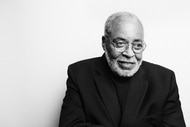Create a free profile to get unlimited access to exclusive videos, sweepstakes, and more!
Marvel's Darth Vader comics are finally letting the Sith Lord grieve

Despite Darth Vader's status as one of the biggest villains in pop culture, we don't really know a lot about him. Sure, there was a whole trilogy devoted to how he turned to the Dark Side, but Anakin was but a small (if wildly important) linchpin in that story. The Clone Wars animated series did a lot to turn Anakin from an annoying kid to a lovable and tragic hero, while turning the barely-there Padmé from just "the love interest" to an incredibly important figure in the large scheme of things. But the show still focused on fleshing out Anakin’s story in the prequel era. We still don't know a lot about the Anakin who lives in Vader, the Anakin who shows up again when he defeats the Emperor in Return of the Jedi.
Except we have seen this story being told in Marvel's Darth Vader comics, especially Charles Soule and Giuseppe Camuncoli's Darth Vader: Dark Lord of the Sith from 2017, and the most recent Star Wars: Darth Vader by writer Greg Pak and artist Raffaele Ienco. Using decades of films and extra material for hindsight, these comics have explored the side of Vader that struggles with himself and the light within him, leading up to his eventual redemption in Episode VI. Pak's Vader is a man who simultaneously wants to forget about Anakin's wife and desperately wants to know just what happened to Padmé, and to his son.
Darth Vader starts right at the climax of Empire Strikes Back. Though for decades the focus has been on Luke's reaction to discovering his father is the second most evil guy in the galaxy, Pak wanted to flip the script. "He just told Luke that he was his father and invited his son to rule the galaxy at his side — and his son rejects him!" Pak told SYFY WIRE via email. "We're so used to seeing that moment from Luke's horrified perspective. But when it became clear that we had all the green lights [from LucasFilm] to dig deep into the emotional repercussions for Vader, my head exploded."
Indeed, if anything, the Marvel comics have made it clear that Vader's story is one of failure and grief. In the movies, we see Anakin grow darker out of anger and grief over losing his mother and fear that he might lose Padme as well. Charles Soule's comic book run focused on Vader's anger at having failed to save Padmé, and his own body. Pak's run starts with Vader failing to turn his son to the Dark Side, before going on a hunt for whoever hid his son from him and turned him “weak.” Vader knows Anakin Skywalker's wife was pregnant, and he knows she died because of information passed down to him by his new master, and so he heads out looking for answers.
Except Vader doesn't find answers, at least not the ones he's expecting. In the first issue, he meets a shadow of his past. Not Padmé, but her handmaiden Sabé. The handmaiden is part of a group dubbed the Amidalans, who are devoted to the late Queen of Naboo and set to destroy whoever killed Padmé and her trusty “bodyguard,” Anakin. Though Vader, of course, knows the answer to this, he is fully in denial about the whole situation. When he tells Sabé that Padmé was hidden away by traitors to the Empire, and that if she had lived, Padmé would have stood with the Empire, the handmaiden rightfully points out the insanity of such a thing, and accuses Vader of not knowing the former Queen and Senator. In his anger, and in his shame, Darth Vader lies to himself and to Sabé, pleads ignorance, and promises to find out the ones responsible for Padmé's fate. But at that moment, what convinces Sabé to join Vader is a little slip-up, a hint that Anakin Skywalker still lives beneath the suit of armor. It is not Vader who promises to help, but Anakin Skywalker, who genuinely wants to find out the truth he's hiding from himself.
Throughout the Marvel comics, but especially in this series, Darth Vader has lashed out at his past and everything connecting him to it every chance he gets. He all but destroys Luke's childhood home, as well as the home where Anakin's mother died, and he breaks into Padmé's apartment on Coruscant and her resting place on Naboo. Darth Vader constantly uses flashbacks to connect to what is happening to Vader in the present, and Anakin's history with Padmé. "We found what I hope is an evocative way to use flashbacks throughout our story," Pak says. "With colorist Neeraj Menon giving an eerie red tint to the flashback scenes paired with letterer Joe Caramagna's evocative red internal voice captions for Vader."
These flashbacks, and the way Vader's internal voice seems to contradict what the images show, help highlight the way the series explores Vader's inner struggle, and just how much he is trying to keep Anakin hidden away. Just one issue later, in Issue #3, Vader decides to live the lie he's been telling himself — that he not only killed Padmé, but he also killed Anakin. This is the lie he told Ahsoka in Star Wars: Rebels, and that he would later repeat to his son, Luke, in Return of the Jedi. The audience knows this is a lie — as will Luke — but it is in this moment that Vader most actively tries to kill his past and push himself to the Dark Side. He was manipulated by Palpatine to kill a bunch of Jedi and fight Obi-Wan. He killed Padmé while blinded by rage. But Vader is completely clear in what he's doing when he tells the Amidalans that he is the killer they are looking for.
And yet, Darth Vader is still about connecting the powerful and evil Sith we meet in Empire with the conflicted man we see in Return, and the last two issues have done more to cement the idea that Anakin was always fighting to come out to the Light than the movies ever did. When Vader confronts the Amidalans, he slaughters his late wife's followers, but he is unable to strike down the handmaidens. Instead, he lets them strike him over and over again, as pieces of his time with Padmé flash before his eyes. Issue #5 doubles down on the Vader/Anakin conflict, as the cover itself features the titular character cracked in half by a lightning bolt, Vader on the left, Anakin Skywalker on the right.
At the end of that issue, Vader finds a holorecording of Padmé's death. Not her handing off Luke and Leia to Obi-Wan, but her dying words to her old friend, imploring him that there is still good inside Anakin Skywalker. Once again, as he does several times in the comic book run, Vader sees the Cloud City shaft Luke plummeted down after he rejected his father's invitation to join him. Rather than seeing his son, or his mother, or even his wife, Vader sees Anakin both as a padawan and as a child. His biggest failure lies before him, and also his biggest threat. Now Vader knows that no matter how many times he tells himself that he killed Padmé, he didn't. Now he knows what his wife believed more than anything, the words that his own son would repeat to him on the Forest Moon of Endor — Anakin Skywalker is still alive, and there is good in him.
As Pak notes, the Star Wars prequels "worked in some incredible parallels between key Vader/Padmé scenes and key Vader/Luke scenes," and the comic book is diving even deeper into these parallels. Darth Vader may try to convince himself that he killed Anakin Skywalker all he wants, but all the evidence draws to him feeling deep, desperate grief for the death of Padmé, of his mother, of part of himself. But now he has proof that even after everything that happened, his wife died believing there is good in him.
Pak won't admit this is the moment that sets Vader on a path of redemption, saying "it's worth keeping in mind that Vader may have a long way to go between the events of our story and the beginning of Return of the Jedi, so there are more twists in his emotional story to come," but he does emphasize the importance of Vader discovering Padmé's dying words. "Padmé's presence and influence in Vader's life is absolutely fundamental to his journey and Padmé's final words in Revenge of the Sith absolutely are a tiny light in the darkness that signal a way back for him," he says, "and I'm thrilled that we've been able to tell a story that reinforces that."



























